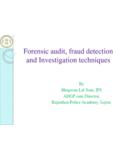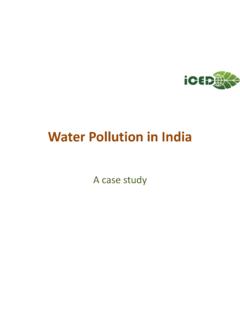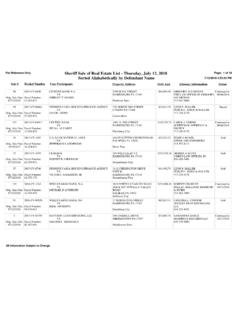Transcription of ENVIRONMENT IMPACTS OF ENERGY SECTOR …
1 ENVIRONMENT IMPACTS OF ENERGY SECTOR (NON-RENEWABLE)Suresh Jain, Professorand HeadDepartment of Natural ResourcesTERI University, New Delhi-110070 Email: schedule for ENVIRONMENT audit of infrastructure and renewable ENERGY projects (17thto 21stAugust, 2015)Non-renewable ENERGY sources Non-renewable ENERGY is ENERGY from fossil fuels such as coal,crude oil,natural gas anduranium. Fossil fuels are mainly made up of of non-renewable ENERGY resourcesSource: November 15, 2014: of non-renewable ENERGY resourcesUsage of non-renewable ENERGY resourcesGrowth in coal consumption slows in the non-OECD Source: ENERGY Outlook 2035 Background Indian context The ENERGY SECTOR is the major contributor to economic and industrial accomplishments as well as a pre-requisite for providing the basic human needs.
2 In India, the main source of electricity generation is coal, which contributes to about ~56% of the electricity generation, whereas natural gas also contributes a significant ~10% towards electricity generation. Overview of installed generation capacity of powerin IndiaREGIONI nstalled capacity (MW)ThermalNuclearHYDRO RES* TOTALCOALGASDSLTOTALN orthern299244671133460816201542444385608 9 Western424798255175075218407448814768186 Southern23032496393928935132011338117695 3362 Eastern223381901722540388241126838N. Eastern608241431027012002282455 Islands--707000676 All India11783318903119911764647803929124998 207006*RES-Renewable ENERGY Sources includes Small Hydro Project(SHP), Biomass Gas(BG), Biomass Power(BP), Urban & Industrial waste Power(U&I), and Wind ENERGY categorized by Ministry of New and Renewable ENERGY , Govt.
3 Of : CEA, 2012 Overview of installed generation capacity of powerin IndiaCOAL57%GAS9%DSL1%Nuclear2%Hydro19%R ES12%Classifying the IMPACTS of ENERGY use By source For example, oil, natural gas, coal, nuclear power, biomass, hydroelectricity etc. By pollutant Pb, CO, Nox, SOx, RSPM (PM1, PM10), SPM, HC, VOC, CH4 etc. By scale Household scale wood burning in developing countries Workplace scale Biomass harvesting and forestry Hydro and wind power Coal, oil and gas Nuclear power Community scale Sulphur dioxide, NOx, CO, Dioxins etc.
4 Regional scale Acid deposition Global scale Global climate changeImpact on human healthThe impact pathway (2031: Winter) (2011: Winter) By2011/12,mostcitiesinthecountryhadalrea dyexceededtheambientairqualitystandard In2011 Infuture, (2031/32)Source: TERI s Integrated MARKAL, WRF, CMAQ Models Results14 Regional scale air quality in India -2011 and projections for Reference Scenario ' 2011 BAU 2031 BAU 2051ES 2031ES 2051CS 2031CS2051 Mortality in millionsCase studyExamples from thermal power Life cycle assessment -a case study of thermal power plantMethodology TheCML2001andEco-Indicator99(H)methodsha vebeenusedformidpointandendpointimpacts, respectivelyusinglifecycleanalysis(LCA).
5 ThisstudyusesISO14040methodologyalongwit h cradletogate approachwhichincludesupstreamandpowergen erationprocesses. Theprimarydatacollectedbypersonalvisitsf orairemissions,wastewater,fuelused,andte chnicalspecifications. Theimpactscategorycomprisedofglobalwarmi ng,acidification,eutrophication,ecotoxic ity,carcinogens,respiratoryorganics, impact assessmentSource:Ecoindicator1999-Hmetho dwouldbeusedforenvironmentalimpactassess mentusingLCAapproachLCA framework used to estimate the life cycle environmental IMPACTS from NGCC thermal power plantSource: Agrawal, K.
6 , Jain, S., Jain, , Dahiya, S., 2014. Assessment of Environmental IMPACTS of Natural Gas Combined Cycle Power Plant using life cycle approach. Environmental Development , conditionsBoundary conditionsBoundary conditionsBoundary conditionsGlobal warming and climate change potential -NGCC thermal power processRemaining processGWP (kg CO2 )(a) Global Warming Potential (CML) + processRemaining processCCP (DALY/kWh)(b) Climate Change potential (Eco-Indicator)Human health damage potential -NGCC processRemaining processesHTP (kg 1,4-DB )(a) Human Toxicity potential (CML 2001) processRemaining processesRespiratory inorganics (DALY/kWh)(c)
7 Respiratory Inorganics potential (Eco-Indicator-99) processRemaining processesRespiratory organics (DALY/kWh)(d) Respiratory Organics potential (Eco-Indicator-99) processRemaining processesCP (DALY/kWh)(b) Carcinogens potential (Eco-Indicator-99)Global warming and climate change potential of 1 kWh electricity generation Imported coal vs. natural + CombustionprocessesCombustion processGWP (kg CO2 )(a) Global Warming Potential (IPCC 2001) Imported + + CombustionprocessesCombustion processCCP (DALY/kWh)(b) Climate Change Potential (Eco-Indicator 99-H) of all processesCombustion processkg 1,4-DB eq.
8 (a) Human Toxicity IMPACTS (CML 2001)Coal TPP with FGDCoal TPP without FGDN atural Gas + of all processesCombustion processDALY(c) Respiratory Organic IMPACTS (Eco-Indicator 99-H)Coal TPP with FGDCoal TPP without FGDN atural Gas + of all processesCombustion processDALY(d) Carcinogenic IMPACTS (Eco-Indicator99-H)Coal TPP with FGDCoal TPP without FGDN atural Gas + of all processesCombustion processDALY(b) Respiratory Inorganics IMPACTS (Eco-Indicator 99-H) Coal TPP with FGDCoal TPP without FGDN atural Gas TPPH uman health damage potential + of all processesCombustion processkg SO2 eq.
9 (a) Acidification IMPACTS (CML 2001) + of all processesCombustion processkg PO4 eq.(b) Eutrophication IMPACTS (CML 2001) + of all processesCombustion processPDF m2 yr(c) Acidification/ Eutrophication IMPACTS (Eco-Indicator 99-H)Coal TPP with FGDCoal TPP without FGDN atural Gas + of all processesCombustion processkg 1,4-DB eq. (a) Fresh Water Aquatic Toxicity IMPACTS (CML 2001) + of all processesCombustion processkg 1,4-DB eq. (b) Marine Water Aquatic Toxicity IMPACTS (CML 2001) + of all processesCombustion processPAF m2 yr(c) Ecotoxicity IMPACTS (Eco-Indicator 99-H) Coal TPP with FGDCoal TPP without FGDN atural Gas TPPU ncertainty analysis for imported coal with FGD vs.
10 Without FGD analysisParameterUnitsCoal based TPPGas based analysis024681012PC - ImportedcoalPC + FGDPC + CCSPC + CCS +FGDIGCCSCNGCCT otal cost ( )Alternate Power Generation Technology Technology cost ( )Total hidden cost (Rs. kWh)References Agrawal, K., Jain, S., Jain, , Dahiya, S., 2014. Assessment of Environmental IMPACTS of Natural Gas Combined Cycle Power Plant using life cycle approach. Environmental Development, Agrawal, K., Jain, S., Jain, , Dahiya, S., 2014. Assessment of greenhouse gas emissions from imported coal and natural gas combined cycle thermal power plants using life cycle approach in India.
















